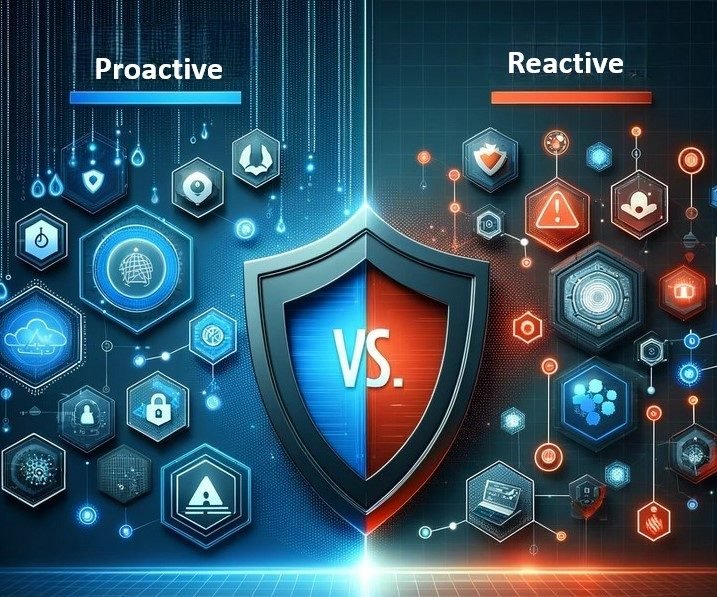Introduction
In today’s complex cybersecurity environment, businesses must carefully choose their approach to network security. The Security Operations Center (SOC) is the heart of an organization’s defense, and selecting the right strategy proactive, reactive, or a blend of both is essential. This article explains the differences between these two approaches and how Digi9 can support businesses in strengthening their security posture.
Defining Proactive and Reactive SOC Approaches

Proactive SOC Approach: This approach focuses on prevention by identifying, analyzing, and mitigating threats before they can harm the network. Proactive security emphasizes continuous monitoring, advanced threat detection, and pre-emptive action, providing a strong line of defense against both known and emerging threats.
Reactive SOC Approach: In contrast, a reactive approach deals with incidents after they occur. The main objective here is to respond quickly, contain the damage, investigate, and learn from the event to improve future defenses. While it may sound passive, reactive security is critical for minimizing the impact of incidents and understanding threat sources and techniques.
Key Differences Between Proactive and Reactive SOC Approaches
- Threat Prevention vs. Incident Response
- Proactive SOC: Implements tools and strategies to prevent attacks, which minimizes the chance of a breach and creates a secure environment.
- Reactive SOC: Focuses on incident response when an issue occurs, with plans to control, investigate, and remediate the situation promptly.
- Security Posture
- Proactive: Constantly enhances security through practices like threat hunting, regular vulnerability assessments, and patch management, aiming for continuous improvement.
- Reactive: Strengthens resilience by learning from incidents and adjusting defenses based on real threats faced, improving the SOC’s adaptability over time.
- Tools and Techniques
- Proactive SOC: Utilizes advanced tools such as Security Information and Event Management (SIEM), machine learning-based anomaly detection, and threat intelligence feeds. Digi9 recommends using these for real-time monitoring and predictive analysis to catch threats early.
- Reactive SOC: Relies on forensic analysis tools, incident response protocols, and backup systems to investigate, contain, and recover from incidents. This includes detailed post-incident reporting to understand the cause and impact.
- Cost and Resource Allocation
- Proactive: Requires higher upfront investments in tools and skilled resources for constant monitoring and preventive actions. However, it can significantly reduce long-term costs by avoiding potential breaches.
- Reactive: Has a lower initial cost, but the expenses of handling and recovering from a breach, along with potential downtime, can add up quickly.
- Impact on Business Reputation
- Proactive SOC: Protects a company’s reputation by preventing breaches and showing commitment to safeguarding client data and privacy.
- Reactive SOC: A fast and effective incident response can help maintain trust, especially if the company communicates transparently about its response to the incident.
Benefits of Each Approach in a SOC
- Proactive Approach:
- Reduces overall security risk by preventing incidents.
- Fosters a security-first culture within the organization.
- Enhances compliance by demonstrating ongoing threat management.
- Protects client data, leading to increased trust and customer loyalty.
- Reactive Approach:
- Prepares teams to respond quickly and effectively to real threats.
- Provides insights into threat actor behaviors, strengthening defenses.
- Supports compliance by establishing well-documented response protocols.
- Allows the SOC to adapt to emerging threats based on previous incidents.
At Digi9, we understand the importance of a well-defined SOC strategy tailored to each business. Our team of cybersecurity experts works closely with clients to develop proactive measures that help prevent breaches and reactive strategies that ensure quick recovery when incidents occur. We specialize in building a comprehensive SOC framework aligned with your business’s goals, so you can maintain a secure and resilient environment.
How to Decide: Proactive or Reactive?
A balanced approach that combines both proactive and reactive measures can provide the most robust defense. Here’s a quick guideline to help:
- High-Risk Businesses (e.g., financial, healthcare): Proactive approach with robust monitoring, threat intelligence, and preventive actions.
- Mature SOCs: Blended approach using proactive strategies for daily operations, with strong reactive capabilities to address any incidents effectively.
- Growing Organizations: Reactive approach initially, followed by gradual integration of proactive tools and measures as resources allow.
Conclusion
Choosing the right approach to SOC network security is crucial. While proactive strategies help prevent threats, reactive measures are invaluable for managing incidents that inevitably arise. A well-integrated strategy, crafted with the support of Digi9, enables businesses to stay ahead of the curve, responding effectively to incidents and continuously improving their security posture.
For more insights on building a resilient SOC tailored to your needs, reach out to Digi9. Let us secure your digital future, one proactive step at a time.







